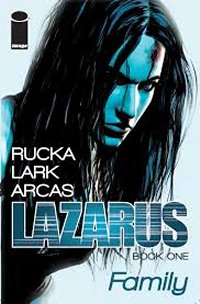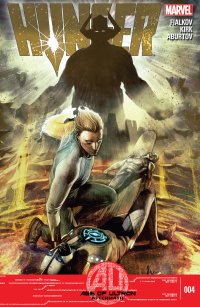Lazarus Volume 1: Family TP (Image, $9.99)
By Adam X. Smith
I had the pleasure of meeting Lazarus artist Michael Lark at the 2006 Comic Show in Birmingham, back when he was still the artist on Ed Brubaker’s run on Daredevil, during which Matt Murdock is imprisoned at Riker’s Island among the same criminals he has fought with and helped incarcerate. I remember telling him that his version of the Kingpin, both in terms of the way he was drawn and his context within the narrative, reminded me of Marlon Brando’s portrayal of Colonel Kurtz, an authority figure in a place of chaos and anarchy. While he said it was not deliberate, I like to think he took the critique in the manner in which it was given: that he was synthesising the codified trope as a means of creating a better shorthand between the creator and the audience. He is neither the first nor the last artist to do this. No real purpose to that little aside – just felt like putting it out there.
And so, Greg Rucka’s Lazarus, a book about genetically and cybernetically enhanced people, used as foot-soldiers for the elite in an era where a handful of interest groups or “families” hold sway over the economy. Protagonist Forever Carlyle aka Eve is essentially and functionally immortal, able to withstand any and all injury, to bring herself back from the brink of death, hence her being given the titular status of Lazarus to her adoptive family.
I could speak at length about the socio-political undertones of this book, about how the members of the Carlyle family represent different aspects of the anarcho-capitalist world in which the story takes place, where corporate interests collide head on with the rough and tumble of squabbling, back-stabbing family members fighting over who gets the biggest piece of the ranch when Big Daddy kicks the bucket. However, in the interest of brevity, I will simply say that it features a fully rounded protagonist who is not the subject of rampant fanservice or sexualisation and yet still manages this whilst being a pro-active and attractive lead character. And in this day and age, that’s something of a novelty.
For its superlative writing and world-building, for the brisk but untroubling pace of this first act of the wider storyline, and for its exceptional use of tonality and mood in the artwork, I give this first volume of Lazarus a hearty recommendation. It’s a bit early to tell whether I will like where it is going, but I can say without doubt that I’m eager to see what’s next.
Rating: 




Out of a Possible 5 Stars
 Three #1 ($2.99, Image)
Three #1 ($2.99, Image)
by D.S. Randlett (@dsrandlett)
300 has always felt like an unlikely icon to me. The film helped catapult Frank Miller’s last “great” work into the public consciousness, but even before then it had been considered a staple amongst comic book readers. Not that it’s bad at all, 300 contains some of the best art of Miller’s career, and it still stands as the last time his hand felt at all sure in the form. But it lacks a certain amount of depth. It’s a work that, as one live with it, starts to resonate as more of a technical achievement than because of its artistic power. But back to its depth: it lionizes the Spartans in a way that has only ever been seen in the modern era. Surely, the stand of the 300 stood as a crucial victory and a landmark moment of bravery and virtue to the peoples of the classical Mediterranean (hence Herodotus writing it down, hence Cicero’s famous tribute, etc.), but notice that these same peoples were not so quick to adopt Spartan ways. After all, Sparta (among others) won that battle, but without subsequent victories by the Athenian navy, Greece would still have been lost. And even though Sparta defeated Athens in the Peloponnesian Wars, it wasn’t long before Spartan culture vanished, the city becoming a shadow of its former self, while Athens remained a jewel in the Mediterranean and the West for centuries to come. Surely, Sparta burnt bright, but it burnt quickly.
Judging from his afterword, writer Kieron Gillen had some similar thoughts upon rereading 300, and thus his new series, Three was conceived as a sort of response. Gillen decides to focus on another side of Sparta. Instead of the wry, yet noble and virtuous, warriors we get brutal slave drivers who treat class inequality as a kind of sport. Gillen isn’t interested in nuance here, he wants to throw a 16 ton weight on the other side of the scales. He does this by crafting something more like a horror story. To do this, he focuses on a group of Helots, members of the slave nation that serves the Spartans. Although, I was quite surprised that Gillen didn’t take advantage of a few fun facts. For example: know how that Spartans got to be such good fighters? By quelling constant Helot revolts. Know why they would send such little contingents to fight in Greek wars? Send to many soldiers away from the city, and the Helots revolt. As of this issue, Gillen doesn’t really get across how Spartans really felt about Helots (they needed and feared them), but he does an effective job of portraying subjugation.
Like 300 before it, this subjugation comes off a simplified exploitation film version of the real thing. I have no doubt that narrative expediency has a lot to do with this, but the true reason is Gillen’s desire to portray the dark mirror image of the image of the Sparta portrayed in 300. Despite some interesting details being blitzed through, Gillen and artists Ryan Kelly and Jordie Bellaire (who do turn in some good work here, the final page in particular is a corker) succeed in plunging us into a story that’s horrific in its immediacy, opening with a scene of young Spartans hunting down Helots for sport. Along with establishing its stakes, the story introduces us to three Helots who, by the end of this issue, are running for their lives. For most of the issue, these characters feel very much like types, but by the end of the issue Gillen has given them unexpected depths and identities, all revealed in a very tense and very well done Inglorious Basterds-style table scene.
Three’s first issue shows some great promise, but it’s hard to recommend as a single issue purchase. It’s a book that will leave you wanting more, for certain, but with this particular book it cuts both ways. Will you want to see what happens in the next issue? Most definitely. Will you wish that there were a little more meat on these bones? Also, most definitely. As a narrative, I have no doubt that this will be a fine companion to 300, and possibly serve to elevate it, but I will be very pleased if Three grows more into its own with subsequent issues.
Rating: 




Out of a Possible 5 Stars
Hunger #4 of 4 (Marvel, $3.99)
By Jeb D.
Back in the pre-Disney days, the Ultimate Universe was Marvel’s attempt to broaden the reach of their intellectual property, by getting new versions of Spider-Man and the X-Men, freed of the accretions of decades of continuity, into the hands of Target and Toys R Us shoppers. Of course, the Ultimate reader turned out not to be a tyke pulling his mom between the Lego and Nerf sections, but the same not-hardly-a-tyke-no-more reader that was already gorging on the standard Marvel U. While the idea of remaining free of the shackles of continuity was obviously always going to be temporary at best, the relatively insular nature of the readership (at least compared with what Jemas and Quesada had in mind) allowed the Ultimate Universe to take some chances with the popular icons. The Ultimates was the first major breakthrough: even those who dislike the series will acknowledge that its influence was key to the development of the nascent Marvel movieverse, and decisions like shattering the Fantastic Four, turning Reed Richards into a supervillain, or killing off Wolverine and Peter Parker, were possible because the “616” versions of those characters were still around to sell lunchboxes and underoos.
And now that economic considerations seem to have demanded an end to the Ultimate line as its own standalone product category, one might have expected its second set of death throes (see: Ultimatum, 2009) to be a marshaling of the still considerable number of familiar faces dotting the Ultimate landscape in one melodramatic clash of spandexed epicness. I suppose it’s possible we’ll see that when Brian Bendis gets all Cataclysmic on us next year, but for now, the story that Joshua Hale Fialkov has crafted to signal the demise of all things Ultimate is almost completely devoid of big names, focusing instead on an intensely annoying version of Rick Jones.
Rick Jones, of course, was the key player at the end of Roy Thomas’ Kree-Skrull War, an “everyteen” whose down-to-earth personality contrasted with the cosmic epic happening around him, and whose climactic invoking of the Timely superheroes of another day was one of the first shots across the superhero meta-textual bow. Fialkov is clearly aiming for something similar here, but he’s turned Rick into such a whining cheeseball that his every appearance makes the reader cringe. And while there’s something to be said for providing contrast between Rick’s personal pettiness, and the galactic burden he has to undertake (yes, he’s Captain Marvel again), the contrast in this case is so jarring as to be unconvincing: I guess if my universe really did need saving, I’d turn to this douche, but not before I’d exhausted every other option.
So it’s Rick and the Kree against the amalgamated versions of Galactus (the big purple guy, and Warren Ellis’ swarm of robotic killing bugs), and artist Leonard Kirk does the action proud: if cosmic comic battles are your thing, this will be right up your alley. As I say, though, a story like this would certainly be enhanced by the presence of the occasional colorful character like Thor or Ben Grimm or Iron Man… hell, over in the regular Marvel U, they’ve sent everyone into space, and one of the reasons Infinity works as well as it does is that Jonathan Hickman recognizes the timeless appeal of those superhero monster rallies. Here, though, Kirk’s working with a limited cast, colorist Jesus Aburtov with an equally limited palette (the only other principal character who’s not mostly green is the Silver Surfer, who doesn’t present a lot of opportunity for visual variety himself), and a story that, if it’s to serve as merely the curtain-raiser for Cataclysm, could have easily been worked into the first issue of that series. As it is, Hunger‘s an awkwardly dull footnote to the fascinating history of the Ultimate Universe (orignal home of the Marvel Zombies, among other things), a quick money-siphon before Bendis delivers the genuine article.
Rating: 




Out of a Possible 5 Stars